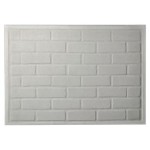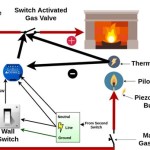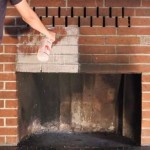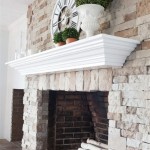Installing Gas Logs in a Wood Burning Fireplace: A Comprehensive Guide
Converting a wood burning fireplace to gas logs offers a convenient and cleaner alternative for enjoying the ambiance and warmth of a fire. This process involves installing gas logs, which are ceramic or refractory logs designed to mimic the appearance of burning wood, and a gas burner system within the existing fireplace structure. While professional installation is highly recommended, understanding the process and its components is crucial for making informed decisions and ensuring a safe and efficient installation.
Before commencing any installation, verifying compliance with local codes and regulations is paramount. Gas line connections and fireplace modifications often require permits and inspections to ensure safety and adherence to established standards. Contacting the local building department or a qualified contractor will provide clarity on specific requirements for the jurisdiction.
The subsequent sections will outline the key steps and considerations involved in installing gas logs in a wood burning fireplace, encompassing preparation, installation procedures, and essential safety precautions.
Evaluating the Existing Fireplace
The first step in preparing for gas log installation involves a thorough assessment of the existing wood-burning fireplace. This evaluation determines its suitability for conversion and identifies any necessary repairs or modifications. A key aspect is measuring the fireplace dimensions, specifically the firebox width, depth, and height. These measurements are crucial for selecting a gas log set that fits appropriately within the firebox, allowing for adequate clearance around the logs and burner assembly.
Chimney inspection is also vital. A clean and structurally sound chimney is essential for proper ventilation and safe operation of the gas logs. A professional chimney sweep should inspect the chimney flue for obstructions such as creosote buildup, bird nests, or other debris. Any necessary cleaning or repairs to the chimney should be completed before proceeding with the gas log installation. Furthermore, ensuring the damper is fully functional is crucial. While some installations permanently fix the damper partially open or remove it entirely, its condition must be assessed to determine the best course of action. A damaged or improperly functioning damper can impede ventilation and potentially lead to the buildup of carbon monoxide.
Another important step is identifying the type of fireplace. There are two main types: vented and vent-free. Vented gas logs require a fully functional chimney to vent the exhaust gases produced during combustion. Vent-free gas logs, on the other hand, are designed to burn more cleanly and do not require a fully open chimney flue. Selecting the appropriate type of gas logs depends on the fireplace configuration and the homeowner's preferences.
Finally, the presence and condition of a gas line near the fireplace must be determined. If a gas line is not already present, running one to the fireplace will be a significant aspect of the installation. This task involves working with gas piping and requires expertise to ensure a safe and leak-free connection. It is generally recommended to engage a licensed plumber or gas fitter for this portion of the project.
Preparing for the Installation
Once the fireplace has been thoroughly evaluated, the next step involves preparing the space for the gas log installation. This includes removing any existing ash, debris, or fire grates from the firebox. Thorough cleaning is essential to ensure a clean and safe working environment. Furthermore, any firebrick or masonry that is loose or damaged should be repaired or replaced before proceeding. Damaged firebrick can compromise the integrity of the fireplace and potentially pose a safety hazard.
Selecting the appropriate gas log set is a critical decision. Gas logs are available in a variety of sizes, styles, and materials. The size should be chosen based on the firebox dimensions, ensuring that the logs fit comfortably without overcrowding the space. The style is a matter of personal preference, with options ranging from traditional-looking logs to more contemporary designs. Materials commonly used for gas logs include ceramic and refractory cement, each offering different levels of durability and heat resistance. Consider the BTU output of the gas log set to match the desired heating capacity for the space. Overly powerful gas logs can make a room uncomfortably warm, while insufficient BTUs may not provide adequate heat.
Gathering the necessary tools and materials is essential for a smooth installation process. Common tools include a pipe wrench, adjustable wrench, screwdriver set, level, drill, and safety glasses. Materials include gas piping, fittings, pipe sealant, a gas shut-off valve, and a connector hose specifically designed for gas appliances. Ensuring that all materials are compatible with natural gas or propane, depending on the fuel source, is crucial for safe operation. Using the wrong type of pipe sealant, for example, can lead to gas leaks.
Finally, the area surrounding the fireplace should be protected from potential damage during the installation process. Drop cloths or plastic sheeting can be used to cover floors and furniture, preventing scratches and spills. Ensuring adequate ventilation in the room is also important, especially when working with gas lines. Opening windows and doors will help to dissipate any gas fumes that may be released during the installation.
Installing the Gas Logs and Burner System
The installation of the gas logs and burner system involves several critical steps that must be followed carefully to ensure safe and efficient operation. First, the gas supply line must be connected to the gas shut-off valve. This connection should be made by a qualified plumber or gas fitter, ensuring that all connections are properly sealed and leak-tested. Using pipe sealant specifically designed for gas lines is essential to prevent leaks.
Next, the burner assembly is placed within the firebox. The specific installation instructions will vary depending on the type of burner system, but generally involves securing the burner to the fireplace floor using screws or brackets. It's crucial to ensure that the burner is level and properly positioned within the firebox to allow for even flame distribution. The connector hose is then used to connect the burner assembly to the gas shut-off valve. This hose should be specifically designed for gas appliances and should be free of any kinks or damage.
Once the burner assembly is connected, the gas logs are carefully arranged on top of the burner. The arrangement should be done according to the manufacturer's instructions, ensuring that the logs are properly spaced and positioned to create a realistic flame pattern. Avoid blocking the burner ports with the logs, as this can impede the flow of gas and affect the flame quality.
After arranging the logs, a leak test should be performed on all gas connections. This can be done using a mixture of soap and water. The mixture is applied to all connections, and any bubbles indicate a gas leak. If a leak is detected, the gas supply should be immediately shut off and the connection tightened or repaired.
Finally, the gas logs should be tested to ensure proper operation. The gas supply should be turned on, and the burner ignited according to the manufacturer's instructions. Observe the flame pattern and ensure that it is even and consistent. Adjust the gas flow as needed to achieve the desired flame height and heat output. Ensure that the venting system is functioning properly and that there is no evidence of carbon monoxide buildup. A carbon monoxide detector should always be installed near the fireplace to provide an early warning of any potential hazards.
Throughout the installation process, strict adherence to safety precautions is paramount. Always wear safety glasses to protect eyes from debris. Work in a well-ventilated area to minimize the risk of gas inhalation. Never smoke or use open flames near gas lines. If any doubts or concerns arise during the installation, consult with a qualified professional.
In summary, installing gas logs in a wood burning fireplace requires careful planning, preparation, and execution. By following these guidelines and prioritizing safety, a homeowner can enjoy the benefits of a convenient and efficient gas fireplace while maintaining the aesthetic appeal of a traditional wood-burning fireplace. However, for individuals lacking experience with gas line connections or fireplace modifications, professional installation is strongly recommended to ensure safety and compliance with local codes.

Can I Install Gas Logs In My Existing Fireplace Thomas Bros Propane

Vented Gas Logs Heater Or Decorative Bart Fireside

Gas Logs Vs Wood Burning Who Wins Vertical Chimney Care

Convert To Gas Installing Fireplace Inserts Doctor Flue

How To Install A Log Lighter Fireplace Gas Starter Pipe

Can I Put Gas Logs In My Fireplace Vertical Chimney Care

Can A Wood Burning Fireplace Be Converted To Gas The Flame Company
Can I Convert My Wood Burning Fireplace To Gas Woodlanddirect Com

How To Select And Install A Gas Fireplace Log Set Fireplaces Direct Learning Center

Why Is It Important To Get My Gas Fireplace Logs Clean Regularly
Related Posts








